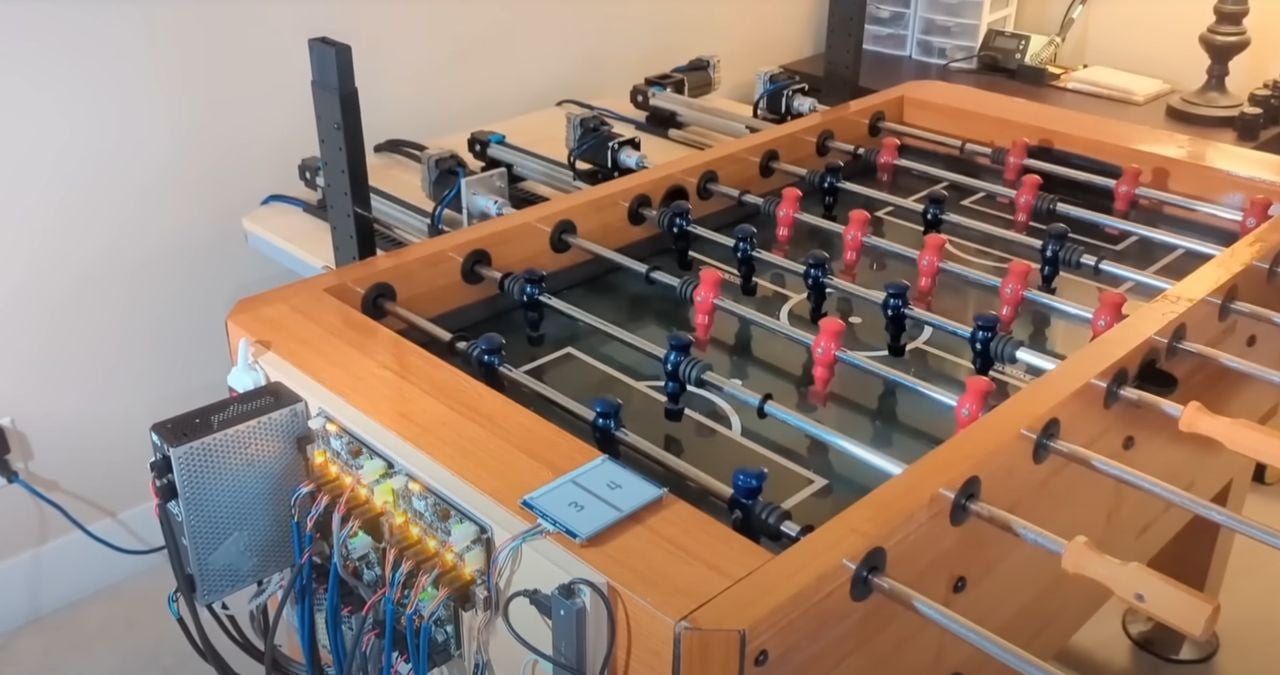
[ad_1]

In a remarkable feat of engineering, Xander Naumenko otherwise known as YouTuber From Scratch has created an fantastic autonomous robotic foosball table designed to challenge and compete with human players. This awesome project tackled significant hurdles in the fields of robotics, vision systems, and software development, resulting in a robot capable of advanced ball control, passing, and shooting capabilities that often surpass those of its human opponents.
The primary motivation behind this project was to automate the game of foosball, enhancing both productivity and entertainment. The team set out to develop a robot with superior skills in ball control, passing, and shooting, allowing it to compete effectively against human players. This ambitious goal required a multidisciplinary approach, combining expertise in mechanical engineering, computer vision, and software development.
Robotic Foosball Table Components and Design
The robotic foosball table consists of several key components that work together seamlessly to achieve its impressive performance:
- Robotics: The robotic system incorporates two types of motion: side-to-side and rotational. Powerful motors and linear belt drives enable precise and swift movements, ensuring that the robot can react quickly and accurately during gameplay. This advanced motion control allows the robot to position itself optimally and execute complex maneuvers with ease.
- Vision System: Initially, the team experimented with a single camera setup that relied on color filtering to track the ball. However, this approach encountered challenges related to occlusion and accuracy. To overcome these limitations, the final solution employed a sophisticated 3D motion tracking system with multiple cameras. This setup provides a comprehensive view of the playing field, eliminating occlusion issues and enhancing tracking precision.
- Software: The software development process focused on creating effective control strategies for both defensive and offensive play. The team had to address physical inaccuracies and ensure precise control of the robotic components. The resulting software is capable of adapting to various game scenarios, making real-time decisions to optimize the robot’s performance.
Throughout the development process, the team encountered numerous challenges that required innovative solutions:
- Mechanical Issues: The initial low-quality foosball table used in the project posed stability and ball control issues. To address this, the team upgraded to a high-quality Tornado table, which provided a more stable platform and improved ball handling. Additional adjustments were made to enhance the robot’s ability to control the ball effectively.
- Vision and Tracking: Occlusion problems, where the ball would be hidden from the camera’s view, presented a significant challenge. By switching to a 3D motion tracking system with multiple cameras, the team was able to eliminate these issues and obtain a clear and accurate view of the ball’s position at all times.
- Software Development: Developing the software for the autonomous foosball table required extensive trial and error. The team had to account for the physical dynamics of the game and handle various edge cases to ensure that the robot could perform consistently under different conditions.
Here are some other articles you may find of interest on the subject of Robotics
Open Source Design
The autonomous robotic foosball table has demonstrated impressive performance in testing and competitions against human players. The robot exhibits superior reaction speed and shot accuracy compared to its human counterparts. However, there are still limitations in terms of ball control and passing consistency, which the team continues to work on improving.
In addition to its autonomous capabilities, the robotic foosball table offers several exciting features:
- Remote Control: Users can control the robotic foosball table remotely via a 3D web app, allowing for interactive gameplay from a distance.
- Open-Source: The project’s code and design files are available on GitHub, encouraging collaboration and further development within the community.
So if you fancy building your very own robotic foosball table Xander Naumenko provides everything you need via the link above to his official GitHub repository.
Video Credit: Source
Filed Under: DIY Projects, Top News
Latest Geeky Gadgets Deals
Disclosure: Some of our articles include affiliate links. If you buy something through one of these links, Geeky Gadgets may earn an affiliate commission. Learn about our Disclosure Policy.
[ad_2]